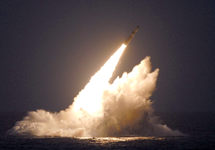Cristina Chuen
March 4, 2002

Submarine Launched Ballistic Missile (SLBM), Source: US Navy
On February 6, 2002, General Staff Deputy Chief Col-Gen. Yuriy Baluyevskiy stated that Russia would shift its attention to the modernization of the naval strategic deterrent. Gen. Baluyevskiy also stated that the condition of Russia’s intercontinental ballistic missile (ICBM) force,which enjoyed modernization priority during the 1990s, will remain “entirely satisfactory” for the rest of the decade. (1) Signs that the naval deterrent was about to receive greater attention were already visible in March 2001, when the Russian government announced its desire to procure 40 sea-launched ballistic missiles (SLBMs), the first such order since 1992. (2) This development coincided with the retirement in March 2001 of Marshal Igor Sergeyev, a career Strategic Rocket Forces (SRF) officer who favored SRF modernization, from the post of Defense Minister. Sergeyev retired following prolonged conflict with General Staff Chief Army General Anatoliy Kvashnin who wanted to reduce the status of the SRF and place greater emphasis on Russia’s conventional forces. Shortly after Sergeyev’s retirement, the SRF were reduced in status from a separate branch of service to a separate command.
The reason for this shift may be the rapidly deteriorating state of the Russian nuclear navy, which is expected to shrink considerably in the next decade. Only one SLBM is currently under construction in Russia (the Borey-class Yuriy Dolgorukiy, laid down in 1996). Delta II and III-class submarines are nearing the end of their service lives. Typhoon-class submarines have greatly suffered from lack of maintenance and their missiles have reached the end of their service lives. By 2010 only the seven Delta IV-class submarines can be expected to remain in service, with the older Delta IIIs and even Typhoons likely to be retired. It is probable that only one or, at most, two Borey-class ballistic missile submarines (SSBNs) will be completed by that time. The rate at which Russian SSBNs are retired could be slowed down if the implied increase in naval deterrent funding would be spent not on new construction but on proper upkeep of existing submarines. However, the resulting gap in construction could mean the disappearance of the Russian SSBN force in a couple of decades. The navy’s material deterioration has also had deleterious effect on the morale of its personnel. In the wake of the Kursk disaster, which revealed major flaws in ship and weapon maintenance and operating procedures and which ended the careers of several admirals and other senior officers, naval personnel’s morale has fallen to an all-time low.
In view of the severity of the problems, it is not yet clear whether the Russian government will be able to reverse, or even significantly delay, the decline of this component of the Russian nuclear triad. Even when the SRF budget in the late 1990s was consuming some 40% of the Russian defense budget, the SRF was limited to fielding 10 silo-based Topol-Ms per year, developing the mobile variant of the Topol-M, and modernizing its aging liquid-fuel ICBMs. In view of the General Staff’s desire to improve the state of Russian conventional forces at the expense of nuclear forces, it is unlikely that the spending on naval strategic assets will reach the level once enjoyed by the SRF. An improvement in the qualitative situation of the Russian nuclear navy can only be expected if the size of the operational fleet is significantly reduced, and doing so would increase the number of retired Russian nuclear submarines whose disposal the Russian government is unable to fund.
In spite of Baluyevskiy’s comments on the state of the SRF, the change of modernization priority to the navy will have negative consequences for the readiness of the SRF. The rate of Topol-M ICBM deployment, the only ICBM currently in production, will likely remain very low for the foreseeable future. While in 1998 and 1999 the SRF received 10 missiles each, in 2000 the rate of deployment dropped to only four, and in 2001 only six were purchased. According to the Ministry of Defense, in 2002 the SRF will receive only six additional Topol-Ms. (3) ICBM modernization programs will likely suffer as well. In 2001, there were already reports that the funding for the SS-19 ICBM life extension program had been sharply curtailed. (4)
Similarly, the reduction of funding of the SRF may overstrain Russian resources for dealing with the accelerated drawdown of the ICBM force such decision implies. The decision to limit modernization efforts of older ICBMs may lead to a higher rate of their withdrawal from service, with a correspondingly greater number of missiles being sent to dismantlement facilities, warheads placed in storage or sent for disassembly, and officers retired from service. If such a draw-down is not sufficiently well financed, the resulting personnel turbulence and instability could result in deterioration of morale among SRF soldiers and officers, with greater risk of incidents involving nuclear weapons. Moreover, demands placed on US foreign assistance programs in these areas may be increased.
Notes
(1) Interfax, February 6, 2002; in “Russia to give navy priority in nuclear weapons building program,” FBIS Document CEP20020206000074.
(2) German Galkin & Dmitriy Zobkov, “Vice Premier Klebanov Saving Missile Makers. Minister Adamov Escaping From ‘Greens’,” Kommersant, March 17, 2001; in “Kommersant Views Klebanov Chelyabinsk Tour, Order for 40 ICBM’s Likely ‘Soon’,” FBIS document CEP20010319000186.
(3) Agentstvo voyennykh novostey, February 6, 2002; in “Russian military prioritizes Navy’s nuclear capabilities,” FBIS Document CEP20020206000126.
(4) Sergey Sokut, “Rossiya menyayet kontseptsiyu stroitelstva yadernykh sil,” Nezavisimoye voyennoye obozreniye, http://nvo.ng.ru, January 19, 2002.
